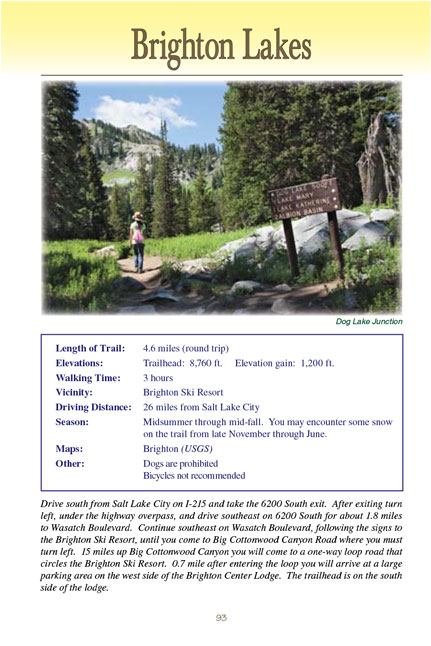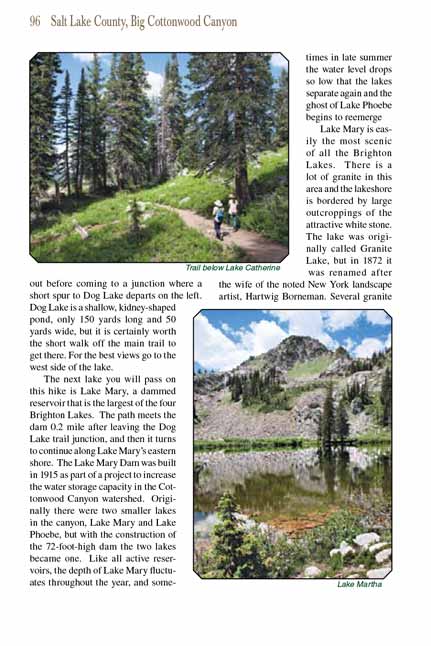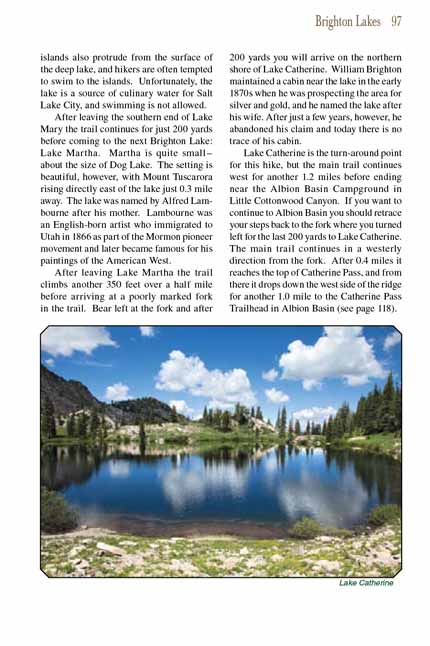Lake Mary and Brighton Lakes
excerpted from our book
Salt Lake City's Incredible Hiking and Biking Trails
pages 93-97
|
Buy book directly from the author!
Salt Lake City's Incredible Hiking and Biking Trails
- has access info for 73 trailheads
- 73 colorful trail maps
- 325 full color photographs
- loads of hiking tips
|
regularly $19.95
now on sale for only
$9.95
click here
for book orders
|


 Brighton and the Brighton Lakes have been a prized destination for residents of Salt Lake City since at least 1857, when the Mormon pioneers held a
celebration there to commemorate the tenth anniversary of their arrival in Salt Lake. The first hotel was built in 1874 by William Brighton, and nineteen
years later, when more recreationists started visiting the area, a larger hotel was opened. Most of the early activity was during summer, but in the 1920s
a group of brash, young adventurers, the early founders of the Wasatch Mountain Club, began making their way to Brighton in the winter to try their hand at
the newly invented sport of skiing. Typically these hardy souls would first journey to Park City; then they would climb to the top of Guardsman Pass and ski
down the west side of the mountain to Brighton. There they would celebrate their achievement with a few days of eating, drinking and partying before making
their way back through Cottonwood Canyon to Salt Lake. Later, in 1936, the Wasatch Mountain Club built the first crude rope tow at Brighton, making the tiny
hamlet Utah’s first fully functional ski resort.
Brighton and the Brighton Lakes have been a prized destination for residents of Salt Lake City since at least 1857, when the Mormon pioneers held a
celebration there to commemorate the tenth anniversary of their arrival in Salt Lake. The first hotel was built in 1874 by William Brighton, and nineteen
years later, when more recreationists started visiting the area, a larger hotel was opened. Most of the early activity was during summer, but in the 1920s
a group of brash, young adventurers, the early founders of the Wasatch Mountain Club, began making their way to Brighton in the winter to try their hand at
the newly invented sport of skiing. Typically these hardy souls would first journey to Park City; then they would climb to the top of Guardsman Pass and ski
down the west side of the mountain to Brighton. There they would celebrate their achievement with a few days of eating, drinking and partying before making
their way back through Cottonwood Canyon to Salt Lake. Later, in 1936, the Wasatch Mountain Club built the first crude rope tow at Brighton, making the tiny
hamlet Utah’s first fully functional ski resort.
Today Brighton remains one of the state’s best known ski resorts, but in the last fifty years it has also become an extremely popular destination for summer
recreationists. The resort is located in the center of a large glacial basin that is surrounded by high mountain peaks and embellished by no fewer than seven
pristine lakes. All of the lakes lie within easy hiking distance from the resort on well-developed trails. The hike described here will take you to four of the
lakes on the south side of the basin that are collectively called the Brighton Lakes. The other three lakes, located west of the resort, were discussed in the
previous chapter.
The Brighton Lakes trail begins by climbing out of the parking lot in a southeasterly direction. Soon it angles to the right and crosses under the Majestic Ski Lift before
continuing its ascent up the south side of the basin. After gaining 500 feet of elevation the path makes an abrupt turn to the right and briefly levels out
before coming to a junction where a short spur to Dog Lake departs on the left. Dog Lake is a shallow, kidney-shaped pond, only 150 yards long and 50 yards
wide, but it is certainly worth the short walk off the main trail to get there. For the best views go to the west side of the lake.
 The next Brighton Lake you will pass on this hike is Lake Mary, a dammed reservoir that is the largest of the four Brighton Lakes. The
path meets the dam 0.2 mile after leaving the Dog Lake trail junction, and then it turns to continue along Lake Mary’s eastern shore. The Lake Mary Dam was
built in 1915 as part of a project to increase the water storage capacity in the Cottonwood Canyon watershed. Originally there were two smaller lakes in the
canyon, Lake Mary and Lake Phoebe, but with the construction of the 72-foot-high dam the two lakes became one. Like all active reservoirs, the depth of Lake
Mary fluctuates throughout the year, and sometimes in late summer the water level drops so low that the lakes separate again and the ghost of Lake Phoebe
begins to reemerge.
The next Brighton Lake you will pass on this hike is Lake Mary, a dammed reservoir that is the largest of the four Brighton Lakes. The
path meets the dam 0.2 mile after leaving the Dog Lake trail junction, and then it turns to continue along Lake Mary’s eastern shore. The Lake Mary Dam was
built in 1915 as part of a project to increase the water storage capacity in the Cottonwood Canyon watershed. Originally there were two smaller lakes in the
canyon, Lake Mary and Lake Phoebe, but with the construction of the 72-foot-high dam the two lakes became one. Like all active reservoirs, the depth of Lake
Mary fluctuates throughout the year, and sometimes in late summer the water level drops so low that the lakes separate again and the ghost of Lake Phoebe
begins to reemerge.
Lake Mary is easily the most scenic of all the Brighton Lakes. There is a lot of granite in this area and the lakeshore is bordered by large outcroppings of
the attractive white stone. The lake was originally called Granite Lake, but in 1872 it was renamed after the wife of the noted New York landscape artist,
Hartwig Borneman. Several granite islands also protrude from the surface of the deep lake, and hikers are often tempted to swim to the islands. Unfortunately,
the lake is a source of culinary water for Salt Lake City, and swimming is not allowed.
After leaving the southern end of Lake Mary the
Brighton Lakes trail continues for just 200 yards before coming to the next Brighton Lake: Lake Martha. Martha is quite
small-about the size of Dog Lake. The setting is beautiful, however, with Mount Tuscarora rising directly east of the lake just 0.3 mile away. The lake was
named by Alfred Lambourne after his mother. Lambourne was an English-born artist who immigrated to Utah in 1866 as part of the Mormon pioneer movement and later
became famous for his paintings of the American West.
After leaving Lake Martha the Brighton Lakes trail climbs another 350 feet over a half mile before arriving at a poorly marked fork in the trail. Bear left at the fork and
after 200 yards you will arrive on the northern shore of Lake Catherine. William Brighton maintained a cabin near the lake in the early 1870s when he was
prospecting the area for silver and gold, and he named the lake after his wife. After just a few years, however, he abandoned his claim and today there is no
trace of his cabin.
Lake Catherine is the turn-around point for this hike, but the main trail continues west for another 1.2 miles before ending near the Albion Basin Campground in
Little Cottonwood Canyon. If you want to continue to Albion Basin you should retrace your steps back to the fork where you turned left for the last 200 yards
to Lake Catherine. The main trail continues in a westerly direction from the fork. After 0.4 miles it reaches the top of Catherine Pass, and from there it
drops down the west side of the ridge for another 1.0 mile to the Catherine Pass Trailhead in Albion Basin (see page 118).
Note to web developers: You may copy this material onto your site, but in return please include a link to my home page
www.utahtrails.com. Thank you, David Day (utahdavidday
at gmail.com)
Click here to see more
trails near Salt Lake City
© Rincon Publishing Company, all rights reserved
|


 Brighton and the Brighton Lakes have been a prized destination for residents of Salt Lake City since at least 1857, when the Mormon pioneers held a
celebration there to commemorate the tenth anniversary of their arrival in Salt Lake. The first hotel was built in 1874 by William Brighton, and nineteen
years later, when more recreationists started visiting the area, a larger hotel was opened. Most of the early activity was during summer, but in the 1920s
a group of brash, young adventurers, the early founders of the Wasatch Mountain Club, began making their way to Brighton in the winter to try their hand at
the newly invented sport of skiing. Typically these hardy souls would first journey to Park City; then they would climb to the top of Guardsman Pass and ski
down the west side of the mountain to Brighton. There they would celebrate their achievement with a few days of eating, drinking and partying before making
their way back through Cottonwood Canyon to Salt Lake. Later, in 1936, the Wasatch Mountain Club built the first crude rope tow at Brighton, making the tiny
hamlet Utah’s first fully functional ski resort.
Brighton and the Brighton Lakes have been a prized destination for residents of Salt Lake City since at least 1857, when the Mormon pioneers held a
celebration there to commemorate the tenth anniversary of their arrival in Salt Lake. The first hotel was built in 1874 by William Brighton, and nineteen
years later, when more recreationists started visiting the area, a larger hotel was opened. Most of the early activity was during summer, but in the 1920s
a group of brash, young adventurers, the early founders of the Wasatch Mountain Club, began making their way to Brighton in the winter to try their hand at
the newly invented sport of skiing. Typically these hardy souls would first journey to Park City; then they would climb to the top of Guardsman Pass and ski
down the west side of the mountain to Brighton. There they would celebrate their achievement with a few days of eating, drinking and partying before making
their way back through Cottonwood Canyon to Salt Lake. Later, in 1936, the Wasatch Mountain Club built the first crude rope tow at Brighton, making the tiny
hamlet Utah’s first fully functional ski resort.
 The next Brighton Lake you will pass on this hike is Lake Mary, a dammed reservoir that is the largest of the four Brighton Lakes. The
path meets the dam 0.2 mile after leaving the Dog Lake trail junction, and then it turns to continue along Lake Mary’s eastern shore. The Lake Mary Dam was
built in 1915 as part of a project to increase the water storage capacity in the Cottonwood Canyon watershed. Originally there were two smaller lakes in the
canyon, Lake Mary and Lake Phoebe, but with the construction of the 72-foot-high dam the two lakes became one. Like all active reservoirs, the depth of Lake
Mary fluctuates throughout the year, and sometimes in late summer the water level drops so low that the lakes separate again and the ghost of Lake Phoebe
begins to reemerge.
The next Brighton Lake you will pass on this hike is Lake Mary, a dammed reservoir that is the largest of the four Brighton Lakes. The
path meets the dam 0.2 mile after leaving the Dog Lake trail junction, and then it turns to continue along Lake Mary’s eastern shore. The Lake Mary Dam was
built in 1915 as part of a project to increase the water storage capacity in the Cottonwood Canyon watershed. Originally there were two smaller lakes in the
canyon, Lake Mary and Lake Phoebe, but with the construction of the 72-foot-high dam the two lakes became one. Like all active reservoirs, the depth of Lake
Mary fluctuates throughout the year, and sometimes in late summer the water level drops so low that the lakes separate again and the ghost of Lake Phoebe
begins to reemerge.